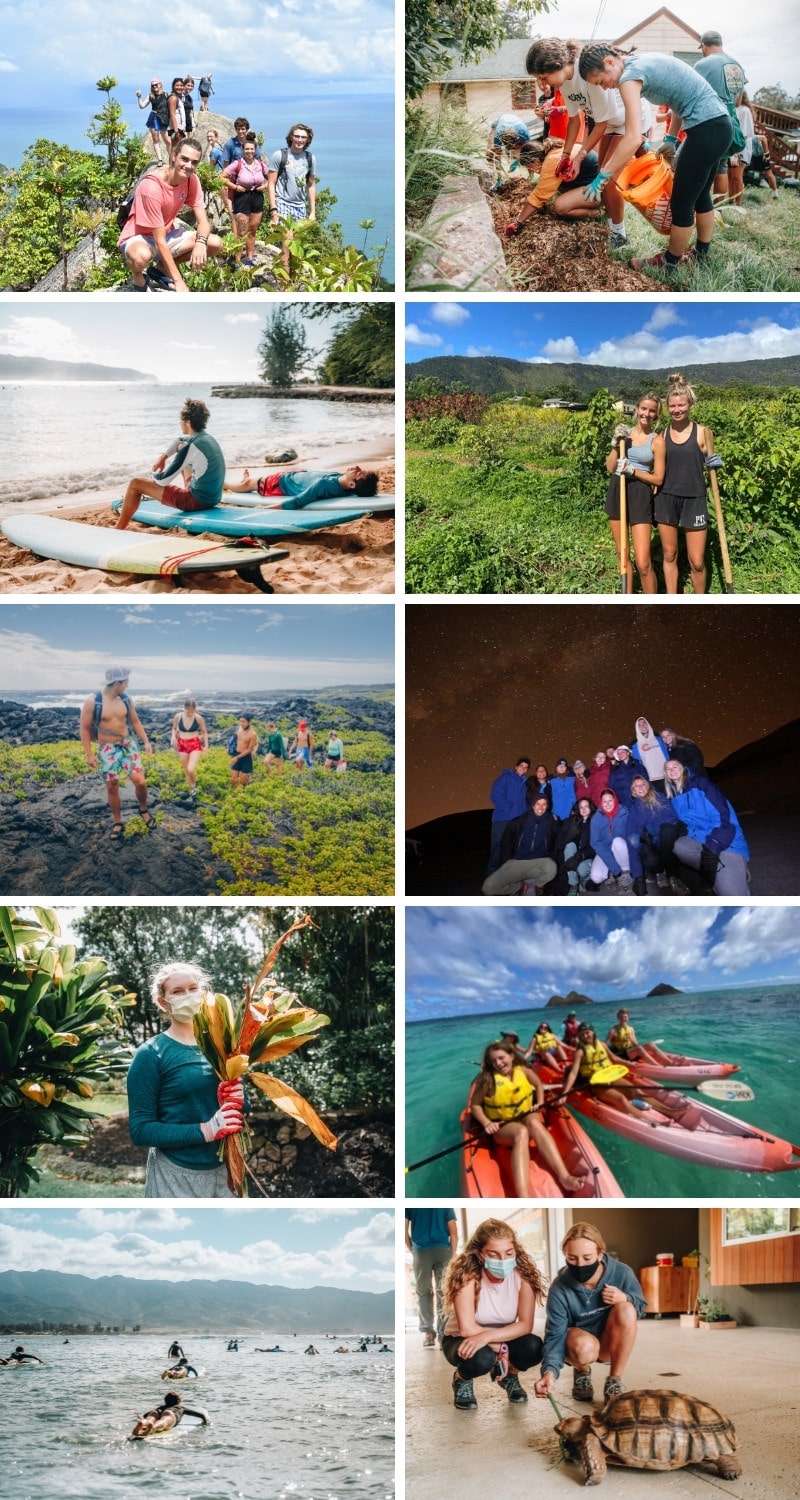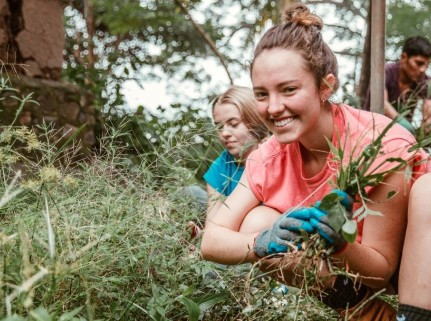
There is an endless list of things to do in Hawaii. From learning to smash open coconuts and making beautiful leis, to stargazing on top of a dormant volcano and heading out to one of only four green sand beaches in the world. Immerse yourself in Hawaiian culture as you discover its fascinating ocean and mountain landscape and explore the incredible jungle, volcanoes, and beaches.
During this six-week program, a key focus will be to connect yourself to the land and the sea. You will learn about sustainable living from local non-profits, and roll up your sleeves at a permaculture farm practicing Hawaiian farming techniques. From the land, we'll move on to the sea. You will not only experience the turquoise water of the ocean during surf lessons and a snorkel excursion, but you will also have the opportunity to delve deep into marine conservation with a fishpond restoration project, learning how to protect and encourage the fragile sea life in these pockets of the ocean.
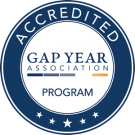
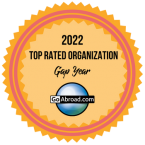
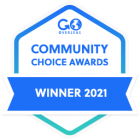
✓ Want to relax on some of the most beautiful beaches in the world
✓ Are interested in immersing yourself in Hawaiian culture
✓ Love activities like surfing, snorkeling and hiking
✓ Are enthusiastic about conservation and agriculture
✓ Would like to go camping and spend time in nature
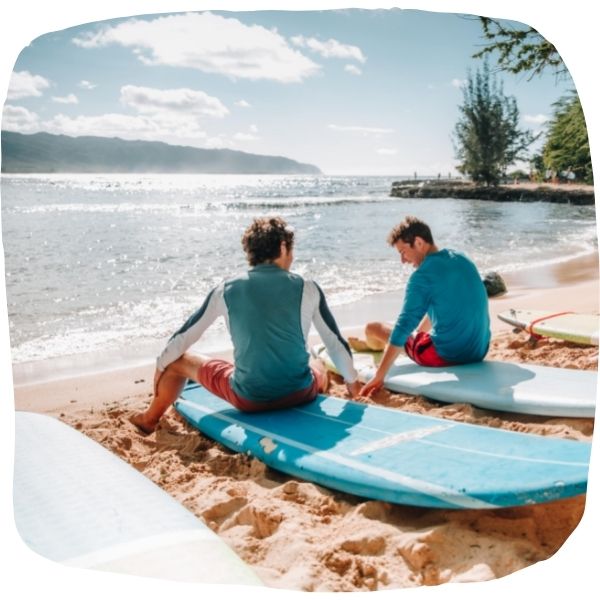
I grew as a person, accomplished things I never thought I could and tried new things such as hiking and yoga and ended up loving both. I gained confidence from start to finish on this program and I’m proud of how far I’ve come. From early mornings having breakfast, getting ready for what the day holds whether it was the beach, a hike, a workshop or agricultural work, to cooking together and playing games before getting ready for bed. I couldn’t be more happier to know I’ve spent the days with the people I did. Learning and growing with them physically, mentally and spiritually.”
- Allyson Vella, 2021
Our Program Quiz can help you find your perfect Program match! Or get the full Program run-down in our catalogue. This catalogue provides information about Pacific Discovery's values and program design, as well as program descriptions and testimonials!
**This is a guide to what you can expect to do on Program. The order in which the activities occur might vary**
Aloha! On arrival in Hilo, you will be met by your program instructors. We are taking a trip to the small town of Pahala in the district of Ka’u, where we will have a comprehensive program briefing and take a deep dive into native Hawaiian traditions, from making beautiful and delicate leis from the local trees to learning the importance of Hawaiian history and how that has shaped the place we are visiting today. We will even learn the basics of Hawaiian language to get a more connected experience.
Pahala is known for its black sand beaches and abundant wilderness, fuelled by the warm sunny days and nightly rainfall that is common on this side of the island. It’s also time to fully embrace one of the oldest Hawaiian traditions, the Imu, a form of underground oven. We’ll ground taro leaves, set the stones and prepare the food whilst sharing stories with our local hosts and when it’s ready, we’ll get to work taking the food from the ground to the table, ready to feast!
There are so many unique landscapes on this environmentally rich island, and the next few days have you exploring one of the coolest! This is sure to be an adventure of otherworldly perceptions, with self exploration and hiking throughout Volcanoe National Park, one of the most unique landscapes in the world.
In 2018, it was also the primary location of a volcanic eruption, which has led to extremely rugged, largely underdeveloped infrastructure. We learn about the impacts the lava flows have had on the local farming practices, and explore the still-cooling lava rocks as well as the stunning seaside cliffs on the coastline. We will walk through barren lava fields and experience exceptional views of the active volcano Kilauea Caldera and a volcanic crater. The adventurous spirits even get the chance to end the day with an evening hike to watch an unforgettable sunset and see lava glow from a crater!
By the end of the week, we will have grasped the value that native Hawaiian’s hold for their local land. It provides them with the food which they eat, the water which they drink, and the energy which they cultivate. We will explore one of only four green sand beaches in the world to take in all its beauty.
Ohh, Hilo on the eastern side of the island, with its rainforests and lush green landscape, it’s a much different vibe and energy. We’ll spend our days exploring the Japanese Gardens and Coconut Island, hiking to some spectacular waterfalls like Akaka Falls, getting fresh fruit at the local farmers market, and venturing down the mysterious Kaumana caves. We’ve scheduled our yoga sessions for the morning to allow for relaxation, and to start our days present and fulfilled.
We’ve also been given an incredible opportunity to get out into the water with a locally run community organization that focuses on fishpond restoration and ocean conservation. We will be working alongside experts learning about the marine ecosystem and how to protect and encourage sea life in these beautiful pockets of the ocean that surround Hilo. We will get to learn about sustainable fishing techniques as well as testing our own skills and trying our hand at throwing fishing nets. Prepare to get stuck in mud and get a little wet over these days!
We will also feel like we’re on top of the world... or, at least, on top of the island. Mauna Kea, a dormant volcano, sits at nearly 14,000 feet above sea level. The majority of the volcano is underwater and when measured it is right around 33,500 feet tall, topping it as the tallest mountain in the world. It is known as one of the best stargazing skies in the world, and we will have the opportunity to lay on its summit and view it for ourselves!
We travel to Hamakua, an area that used to be covered with sugar cane, and continue with our exploration of local agriculture this week. The region is also known for the most beautiful stretches of scenery on the island, and you will be amazed by the stunning vistas, tranquil green valleys and trickling waterfalls.
This week will be a whirlwind of experiences. We’ll spend some time at a permaculture farm and learn about the local area’s farming techniques and the medicinal properties of plants, see the sacred Waipio Valley, and meet the local coconut master who will teach us how to smash open coconuts and use up every single element from the skin to the shell. We will also use some of the vegetables and nutrient-rich ingredients that we harvest on the farm to create a delicious vegetarian meal for the group, while also learning about the importance of minimizing our carbon footprint and building relationships with local farmers.
Seeing the ocean everyday might have made you wonder about the fascinating living ecosystems that make up the coral reefs under the water surface, so it’s the perfect time to learn more about marine biology with a workshop. We even get the opportunity to make our very own reef-safe sunscreen!
We head to Kohala, where we will learn about the importance of the canoe in the local communities. Much in the way that the hula is not just a dance, canoes are not just boats in Hawaiian culture. Polynesian voyagers first discovered the Hawaiian islands, and canoes played a key role in the flourishing of Hawaiian life. We learn how canoes were an important part of everyday life, especially for traveling and fishing, and how locals are still heavily involved in canoe voyaging clubs.
We are very lucky to be able to spend some time in this area of Hawaii. While we’re here we will roll up our sleeves and get involved in the efforts of a non-profit while learning all about the legends and land from Aunty K! This hands-on non-profit was founded for research and educational purposes to discover and understand how Hawaiians sustained rain-fed intensive farming for centuries; and how it may inform our current efforts to live sustainably.
We then make our way to the sunny side of Kona and immerse ourselves in the epic nature surrounding our new home base. We will go for an evening snorkel with manta rays, while keeping our eyes peeled for dolphins and other marine life. Manta rays are attracted by plankton, which in turn are attracted by bright lights, so our lighted raft is sure to bring in some of these majestic wild animals. Snorkeling around the raft and seeing the manta rays swim gracefully underneath us is an experience that we will never forget!
Time to reset and refresh at our new homebase for the second half of the program: Oahu Island! We make our way from Honolulu to Haleiwa because let’s be honest, can you consider yourself to truly understand the culture of Hawaii if you don’t get on a board and walk the walk? Or more aptly, surf the surf?
For three days we will have surf lessons from a local legend, who is sure to get even the clumsiest and most unathletic of us at least skillfully wobbling on the waves. We’ll learn to laugh at ourselves as we no-doubt tumble into the turquoise waters and we’ll learn to trust ourselves as we slowly develop the skills and strengths needed to master this graceful art. These days are physically exhausting, so the afternoons will be quite a bit of rest and relaxation, so we’ve got plenty of time to recharge our batteries. We will also get the chance to go snorkeling in the reef-protected Shark Cove, which did not get its name from unwanted visitors, but from its shape that resembles a shark.
Having traveled around two of Hawaii’s islands by now, the Big Island and Oahu, we will discuss the contrasts between the two and the impact tourism has had on Hawaii. We’ll spend these days partnered with local communities and experts maintaining and restoring wilderness diversity on Oahu. Prepare yourselves to learn about habitat creation and maintenance, the different species of flora and fauna that live on the island and learn about invasive species removal and its importance in conservation. We’ll be getting outdoors and learning all there is to know, expect to get grubby and a little wet during these days of service!
Back in Honolulu, we will be treated to an experience unlike any other - what goes on when a museum is closed (Okay, fine, otherwise known as Night at the Museum. But funnier. And cooler. Unless you thought it was funny and cool, in which case this is it).
We will also give a helping hand to the Hawaiian food bank, which serves food in a variety of ways depending on the needs of the communities. These include food pantries, homeless shelters, soup kitchens, domestic abuse shelters, rehabilitation centers and more. We can make a difference by inspecting the food products, sorting them and boxing them for distribution. We will feel good knowing that we have played a part in ensuring no one in Hawaii’s ‘ohana’ (family) goes hungry.
We will visit Hanauma Bay, a Natural Preserve, a protected marine life conservation area. “Hana” is the Hawaiian word for Bay, and “uma” refers to curves of the indigenous canoes. We will learn about marine life, preservation,and snorkeling with hundreds of tropical fishes and marine life.
At the end of this incredible adventure, we admire the Moana Falls as they cascade 150 feet down the mountainside, and walk around gardens that boast a collection of 5,660 thriving tropical plants and trees. When our feet have grown tired, we will give our arm muscles a workout during an afternoon of ocean kayaking. We will search for secret spots throughout the bay, keep our eyes peeled for marine life and give ‘kayak surfing’ a go when paddling back to shore.
Sadly, the time has also come to begin processing the once-in-a-lifetime experiences that the last 42 days have taken us on. We are sure that you will reflect on how amazing it was to have a chance to take a break from everything, learn about ourselves, but also prioritize time to experience and have gratitude for our own beautiful and historic culture and environment.
*Each week there will be some designated free time so that you can catch up on email, laundry, rest, and explore independently with others in the group.
**Pacific Discovery reserves the right to alter and/or change the order of the itinerary, the focus of the projects or the activities themselves due to dates, availability, and safety precautions.
✓ All in-program travel and transport, excluding flights
✓ All accommodation
✓ All meals
✓ All expeditions, activities, excursions, volunteer projects and entry fees as described in the itinerary
✓ Experienced Program Instructors and local guides
✓ Informal lectures from resident experts on conservation and eco-tourism
✓ Experiential core curriculum that pushes students to reflect and ask questions of themselves
✓ Certificate of Program Completion
![]()
![]()
![]()
Medium Activity Level: Anyone with an average fitness level and an enthusiasm for the outdoors and new experiences will have a great time on this gap semester! You will need to be prepared for some physical work during the volunteer projects on the program, like trail building or the removal of invasive plants.
![]()
![]()
Medium Camping Level: Be prepared to spend some time out in nature. You'll love the experience of camping, staring at the camp fire, breathing in fresh air and stargazing the night away.
![]()
![]()
![]()
High Service Learning Level: You will be able to make a big difference to the local community during your stay. Be prepared to get your hands dirty and do some hands-on learning about local issues.
Our accommodation will be a mix of camping (tents supplied), Yurts, Houses, Hostels, and lodges. Laundry and Wi-Fi facilities will be available some days, except during the weeks in the field on the volunteer projects and on expeditions. Accommodation is diverse, comfortable and carefully chosen to fit our needs.
Meals are fresh, tasty, healthy and varied. Special dietary requirements and vegetarians are catered for. Breakfast, lunch and dinner are included in the program cost. Any snacks are at an additional cost, which we recommend budgeting around $15 per day for.
Food preparation responsibilities are shared by all students. It’s fun, social and often a highlight. An average day on program would consist of the following:
Camping meals will be adjusted to the cooking equipment at hand
To make things easy for you, we partner with a full service travel agency that can arrange flights, appropriate travel insurance and post program arrangements for our students.
They have access to a "Cancel For Any Reason" or CFAR travel insurance for US citizens in participating states. This optional travel insurance product allows travelers to cancel for any reason whatsoever up to two days prior to departure and still receive a significant refund. This allows you to keep planning for the future while avoiding the stress and the financial worry of canceling a program if you need to.
Our program locations and itineraries have been carefully selected and modified to minimize risk of exposure to anyone outside the group with most being located in rural areas. This allows for a more focused learning environment, as well as a safe haven from the stress of our modern world.
We've been working hard and watching closely to any CDC recommendations about group sizes and testing requirements to come up with options that will allow you to have a safe, healthy, and stress-free Gap Year experience. We do the hard work so you can come and enjoy the fresh air, adventures, and new friends!
We have been running successful gap year programs in Spring, Summer and Fall 2021. The students shared their experiences in testimonials and wrote their stories down in blog posts - feel free to have a look.
Check out the information on our COVID-19 page to find out more about our Covid-19 policies, procedures and updates.
We have answered the most frequently asked questions in the FAQ Section. If you still have any other questions, feel free to schedule a call with our admissions team for more information.
